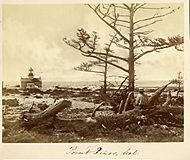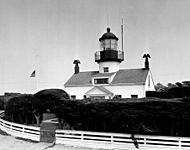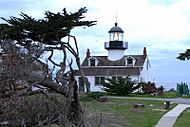Point Pinos Lighthouse facts for kids
| Location | Monterey Bay Pacific Grove, California United States |
|---|---|
| Coordinates | 36°38′00″N 121°56′02″W / 36.633389°N 121.933783°W |
| Year first constructed | 1855 |
| Automated | 1975 |
| Foundation | stone basement |
| Construction | concrete tower |
| Tower shape | cylindrical tower with balcony and lantern rising at the centre of keeper's house |
| Markings / pattern | white tower, black lantern |
| Height | 43 feet (13 m) |
| Focal height | 89 feet (27 m) |
| Original lens | Third order Fresnel lens |
| Characteristic | Oc. W 4s. |
The Point Pinos Lighthouse first shone its light on February 1, 1855. It was built to help guide ships sailing along the Pacific Coast of California. This lighthouse is special because it is the oldest one that has been working continuously on the West Coast of the United States. Even its original lens is still in use today!
Another lighthouse, on Alcatraz Island, started working a bit earlier. However, it was replaced in 1909. The Point Pinos Lighthouse, though, is still an active guide for ships, managed by the United States Coast Guard. The city of Pacific Grove runs a museum at the lighthouse. It is surrounded by the Pacific Grove Municipal Golf Links.
Contents
How the Lighthouse Works
The light source at Point Pinos is 89 feet (27 m) above sea level. It uses a powerful 1 kilowatt bulb. This bulb creates a bright beam that can be seen up to 15 nautical miles; 27 kilometres (17 mi) away on clear days.
Before 1975, someone had to turn the light on and off every day. It was lit one hour before sunset and turned off one hour after sunrise. But in 1975, the lighthouse became automated. This means machines now control it. A small battery-powered backup light was added outside the tower. The main light now stays on all the time.
The light has a simple pattern: it's on for 3 seconds, then off for 1 second. In the past, there was also a radio beacon and a foghorn. The radio beacon helped ships find their way up to 20 miles (30 km) away. The foghorn would sound when it was foggy. However, with modern GPS navigation, these older aids are no longer needed. So, the radio beacon and foghorn were turned off in 1993.
History of the Lighthouse
The Special Lens
The light inside the Point Pinos Lighthouse uses a special lens called a Fresnel lens. This lens, with its many parts and prisms, was made in France in 1853. A bigger lens was originally planned for Point Pinos. But because of shipping delays, this smaller lens, which was meant for the Fort Point Lighthouse in San Francisco, was installed here instead.
Light Sources Over Time
When the lighthouse first opened, it used a whale oil lantern. The lightkeeper had to climb the tower many times each night to fill the oil tank. Whale oil was very expensive. Soon, it was replaced by cheaper lard oil. Then, in 1880, kerosene became the fuel. Around 1900, an incandescent vapor lamp was used. Finally, in 1919, electric lights were installed.
From 1912 to 1940, a special rotating metal shutter was used. It would spin around the light, blocking the beam for 10 out of every 30 seconds. After that, a timed flasher created the "on/off" pattern we see today.
Building the Lighthouse
In 1874, Lighthouse Avenue in Pacific Grove was built. This road helped transport supplies and building materials from the port in Monterey to the lighthouse.
The land where the lighthouse stands was once part of a large Mexican land grant called Rancho Punta de Pinos. In 1850, after California became part of the United States, the government decided to build lighthouses along the West Coast. Point Pinos was chosen because it was a dangerous spot at the southern entrance to Monterey Bay. The government bought 25 acres (10 ha) of land for the lighthouse. Later, another 67 acres (27 ha) was purchased. Construction started in 1853. But because of delays in getting the lens from France, the lighthouse didn't open until 1855.
Famous Lightkeepers
The first lightkeeper was Charles Layton. He started the job in 1855. Sadly, he passed away that same year. His wife, Charlotte, then took over as the head lightkeeper. She was the first woman to hold this important job at Point Pinos. Charlotte stayed until 1860, when she married her assistant, George Harris.
Another famous visitor was the writer Robert Louis Stevenson. He visited lightkeeper Allen Luce in 1879. Stevenson wrote about his visit in his book From Scotland to Silverado, praising Luce's kindness and talents.
The most well-known lightkeeper was Mrs. Emily Fish. She worked at the lighthouse from 1893 to 1914. She was known as the "Socialite Keeper" because she loved to entertain guests at the lighthouse.
Today, the Point Pinos Lighthouse is listed on the National Register of Historic Places. This means it's recognized as an important historical site.
Images for kids
-
An old photo from the USCG
-
The lighthouse showing its Fresnel lens
See also
- List of lighthouses in California





